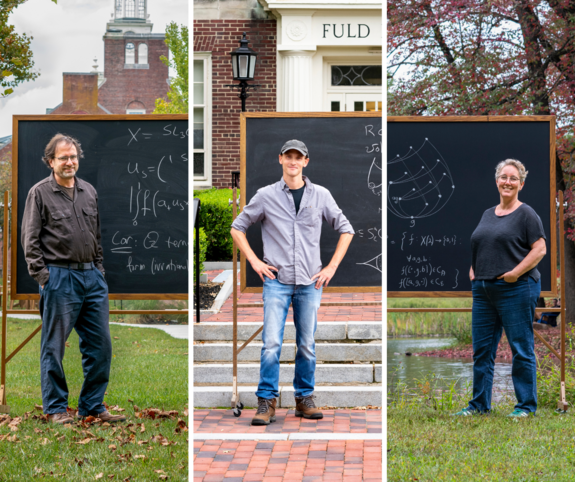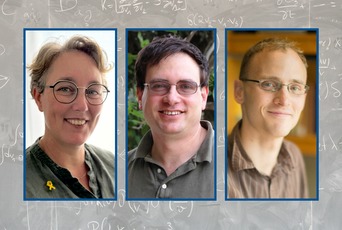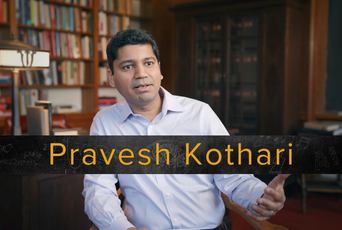The Institute for Advanced Study thrives on conversation, and recently there’s been a lot to talk about. This summer brought exciting news from the School of Mathematics. Three new permanent Faculty commenced their IAS appointments: Irit Dveer Dinur (theoretical computer science), Elon Lindenstrauss (dynamical systems), and Aaron Naber (geometric analysis). These world-leading mathematicians bring unique expertise to the Institute’s scholarly community, further elevating the pursuit of fundamental knowledge at IAS.
Elon Lindenstrauss

“It’s a bit complicated to define my area of mathematics,” explains Elon Lindenstrauss. “I work sort of between areas.”
But working between areas often proves fruitful at the Institute, where Lindenstrauss has, in the past, found much inspiration. “Initially I was influenced by Peter Sarnak,” he explains. “When I came to IAS for post-doc talks, he made a suggestion that turned out to be very useful towards proving some results about eigenfunctions of the Laplacian using dynamics.” Eigenfunctions of the Laplacian are special functions that describe how quantities change in space, such as natural vibration patterns in physical systems. Lindenstrauss’s insights on the subject turned out to be one of his most significant contributions.
Currently, he is focused on developing quantitative results for unipotent flows, a special type of mathematical system that describes how certain objects move or change over time in a smooth and predictable way. It builds upon the qualitative findings of Marina Ratner and Gregory Margulis, Member (1991, 2006) in the School. “They're really wonderful results and have had surprisingly diverse applications,” he notes, continuing, “it’s actually their theorem I have on the board.”
Lindenstrauss’s research builds new bridges between the field of dynamics, which can trace its origins to the study of statistical aspects of long-term evolution of physical systems like the solar system, and number theory. which deals with properties of static objects like integer solutions to equations.
Irit Dveer Dinur

“Sometimes people develop something just for the beauty of it, without any inkling that one day you’ll find uses that you can’t expect,” states Irit Dveer Dinur, walking to the blackboard. As an example of this, she continues: “A few years back, I learned about Ramanujan complexes,” she continues, “but on the face of it, they have nothing to do with my area of study: computation. Nevertheless, we had this intuition that they could be useful or interesting to learn about and that maybe we could use them for something.”
Ramanujan complexes are a type of high-dimensional expander, a mathematical object that exhibits remarkable local-to-global properties. They enable the examination of small pieces of large computations to provide insights into the overall process.
Dinur’s investigations into these complexes, driven entirely by her curiosity, started a journey of several years that involved “learning a lot of really beautiful mathematics.” This ultimately led to a breakthrough: Dinur used high-dimensional expansion to construct error correcting codes. These codes, which are resilient to noise, allow for the detection of errors by examining small portions of the code.
“In the past, I had even tried to prove that such mathematical objects could not exist!” Dinur laughs. “So, it was fantastic to see that they do exist and that they might have future applications we can’t even imagine.” She describes her discovery as the result of pursuing knowledge “purely for its own sake,” exemplifying, in her words, “the founding axioms of the Institute.”
Aaron Naber

“Most of what I study is shapes,” explains Aaron Naber, gesturing to the blackboard behind him. More specifically, Naber studies the mathematical connections between what a shape looks like—its topology—and how it can bend. “The usual 200-year-old version of the story starts with something like a basketball, and you deflate it a little bit. No matter how you move it around, every-one recognizes it’s a basketball. That’s called topology.”
His work focuses on understanding how the equations through which these connections are expressed can, in Naber’s words, “break” or develop singularities, namely points where the shape stops looking smooth. “Basically, they stop looking nice,” he says.
He emphasizes the relationship between topology and optimal shapes, noting that “shapes have one natural form that's better than all the others,” referring to the basketball's spherical form as its most efficient configuration. His work extends to complex, high-dimensional objects that are difficult to visualize but are vital for understanding geometric structures.
“Those connections, between a thing’s topology and the way it bends, are usually in the form of equations that get solved. These equations pop up in all kinds of natural ways for people, but as a mathematician, I don’t care. I usually just study them because they’re interesting.”



